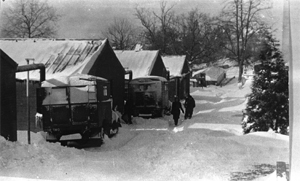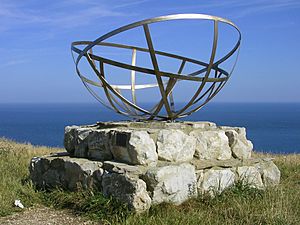Telecommunications Research Establishment facts for kids
The Telecommunications Research Establishment (TRE) was a very important place in the United Kingdom. It was the main group that developed new technologies for the Royal Air Force (RAF) during and after World War II. They worked on things like radio navigation, radar, and special infra-red systems for heat-seeking missiles.
Many people thought TRE was "the most brilliant and successful" research group in Britain during the war. It was led by a man named Rowe. In 1953, its name changed to the Radar Research Establishment. Then, in 1957, it became the Royal Radar Establishment. This article tells you about TRE up to when its name changed.
Contents
History of TRE
TRE is most famous for its work on radar. Radar helped Britain defend itself and attack enemies. But TRE also did a lot of work on radio navigation. This helped planes find their way. They also found ways to block enemy radio signals. Radar was a huge part of their story.
The group started in a place called Bawdsey. Then it moved to Dundee, and later to Worth Matravers. There, it was officially named TRE. After that, it moved to Malvern. Finally, it joined with other groups to become the Royal Radar Establishment.
Starting at Bawdsey
The idea for radar in the UK began in 1935. A committee led by Sir Henry Tizard started looking into it. The first experiments were done by Robert Watson-Watt at Orfordness. They needed a permanent place. One team member remembered an empty house nearby. This became Bawdsey Research Station in 1936. The team was then called the Air Ministry Experimental Station (AMES).
Moving to Dundee
Bawdsey was very close to the Netherlands by sea. This worried the Air Ministry. Watson-Watt planned to move the teams to a safer place if war started. He talked to the head of University College at Dundee. But when the war began in 1939, the AMES teams arrived in Dundee to find nothing ready. There wasn't much space for them.
Also, the teams working on Airborne Interception radar (AI) were sent to RAF Scone. This was a small airfield that was not right for their work. Complaints went up to the Ministry. This led to a search for a better place. Later that year, the AI team moved to RAF St Athan in Wales. But this place was not much better.
Worth Matravers and a New Name
By early 1940, Dundee was clearly not working out. A new spot was chosen near Worth Matravers on the south coast of England. It was close to other research teams. This new place had good views over the English Channel, like Bawdsey. But it had no buildings, so they had to build them quickly. People often called this location Swanage, which was a small town nearby.
The move happened in May 1940. The AMES group was renamed the Ministry of Aircraft Production Research Establishment (MAPRE). It became the main research group for RAF radar. In November 1940, the name changed again to the Telecommunications Research Establishment (TRE).
Life in Malvern
In 1939, the government had a plan to move important groups out of London if there were air raids. A site was bought in Malvern. The Air Ministry took it over. They used it for a Signals Training Establishment.
In February 1942, German battleships escaped through the English Channel. British radar did not spot them. This was because the Germans had been jamming British radar for weeks. The British didn't realize this was happening.
After this, Lord Mountbatten and Winston Churchill approved a raid on a German radar station. This was at Bruneval, in France. A TRE scientist named D. H. Priest was part of the raid. They captured a German radar system and a radar operator. These were brought back to TRE.
The British then worried the Germans might try to raid them. When they heard German paratroopers were coming in May, the TRE staff quickly left the Swanage site. The Telecommunications Research Establishment moved to Malvern. They set up in the buildings of Malvern College, a boys' school. This urgent move is described in a book by R. V. Jones.
After the war ended, TRE moved from Malvern College. It went to HMS Duke, a Royal Navy training school nearby.
Amazing Discoveries and Inventions
Radio navigation systems helped planes find their way using radio signals. R. J. Dippy created the GEE system at TRE. This system made bombing raids much more accurate. It was a very powerful tool.
Radio Jamming
Jamming means blocking enemy radio signals. R. V. Jones was a science advisor. TRE staff worked closely with him. They blocked the German air force's navigation signals. This stopped the enemy from doing accurate night bombing raids. This was called the "battle of the beams".
Robert Cockburn from TRE developed the Jostle IV radio jammer. It was the most powerful jammer used over Europe. It could block all radio signals in a wide range. It was very big and heavy. Test flights had to be done near Iceland. This was so the Germans wouldn't know about the new jamming system.
Radar Technology
Developing radar was super important during the war. It helped with both defense and attack.
- Airborne Interception (AI) Radar: Early work was on AI radar. This radar could be carried in night fighters. It helped pilots find enemy planes in the dark. Britain was facing many night bombings. The first tests were in 1936-37. Later, planes like the Bristol Beaufighter and de Havilland Mosquito used AI radar. The Mosquito became the main RAF night fighter.
- Air-to-Surface-Vessel (ASV) Radar: This radar was for Coastal Command planes. They used it to hunt German U-boats at sea. Early planes like the Lockheed Hudson used ASV. This new equipment helped a lot. It was put on Vickers Wellingtons and Sunderland flying boats. ASV radar helped the Allies win the Battle of the Atlantic. ASV-equipped planes also flew from aircraft carriers.
- Oboe Blind Bombing System: This system was designed by Frank Jones at TRE. It helped planes bomb targets even when they couldn't see them. Oboe was used by Mosquitoes of 109 Squadron. The Mosquito was chosen because it was fast and could fly very high. This helped it avoid being shot down.
- H2S Radar: The H2S radar used a new invention called the cavity magnetron. RAF bombers used it to find ground targets at night or in bad weather. It became a standard part of bombers like the Handley Page Halifax and Avro Lancaster. H2S was even used in the Falklands War in 1982!
- Automatic Gun-Laying Turret (AGLT): This was an airborne radar for bomber gunners. It helped them shoot at enemy fighter planes. It was designed by Philip Dee. Gunners could hit targets without seeing them. It was called 'Village Inn'. AGLT was used on many Lancasters and Halifaxes during the war.
- Radar Trainers: Geoffrey Dummer designed special radar trainers. These helped pilots and gunners practice using radar.
Winston Churchill thought radar was extremely important. Sir Bernard Lovell said that Sir Robert Renwick would call every day. He would ask about any radar news or problems. Renwick could talk directly to Churchill to solve issues.
Other Important Work
- Radar Jamming: Robert Cockburn also developed other radar jamming devices. These included Mandrel, Carpet, Piperack, and Jostle. They were used by planes to fight against German night fighters.
- Electronic Parts: Geoffrey Dummer also led the development of Cathode ray tubes (for radar displays) and other electronic parts.
- Flight Simulators: A.M. Uttley developed flight simulators. These helped pilots train safely on the ground.
- Electronic Computers: Philip Woodward worked on early electronic computer systems.
By 1942, TRE had about 2,000 staff. By 1945, this number grew to around 3,500 people.
What Happened Next
TRE joined with another group in 1953. It became the Radar Research Establishment. In 1957, it was renamed the Royal Radar Establishment. Later, in 1976, it became the Royal Signals and Radar Establishment. The organization continued to change names and join with other groups over the years.
Amazing People at TRE (The Boffins!)
The scientists and engineers at TRE were often called "boffins." Here are some of the key people and what they did:
- James Atkinson: Worked on Cathode ray tubes and infra-red detectors.
- Alan Blumlein: An electronics pioneer. He helped develop a key part of the H2S airborne radar. Sadly, he died in a crash during an H2S test flight in 1942.
- E. G. ("Taffy") Bowen: Was part of the team that first detected an aircraft with radar in 1935. He helped develop airborne radar.
- Robert Cockburn: He led the development of radar jamming systems like Window (also known as Chaff). This helped reduce casualties during air raids. He was later knighted.
- Joan Curran: She invented the Window (Chaff) radio countermeasure system.
- Samuel Curran: Worked on radar at TRE. He later invented the scintillation counter and the proportional counter. He was also knighted.
- Philip Dee: He designed the Automatic Gun-Laying Turret, known as Village Inn. This allowed gunners to hit targets without seeing them.
- Robert J. Dippy: An electronics engineer who was a pioneer in radio navigation. He developed GEE and Loran-A, which were very important for the D-Day invasion.
- G. W. A. Dummer: He developed the plan position indicator for radar displays. He also designed many radar training devices during the war. Later, he was one of the inventors of integrated circuits.
- Antony Hewish: A physicist who worked on antenna design for airborne radar. He later shared the Nobel Prize in Physics in 1984.
- Alan Hodgkin: A scientist who worked on the Automatic Gun-Laying Turret. He later won a Nobel Prize.
- "Frank" Jones: He helped design and develop the Oboe blind bombing system.
- Tom Kilburn: Worked on radar at TRE. He later became a pioneer of computer hardware at the University of Manchester.
- Bernard Lovell: He led the team that developed H2S radar. He later built the famous radio telescope at Jodrell Bank.
- A. P. ("Jimmy") Rowe: A key leader in British radar development from the very beginning. He directed TRE when it moved to Malvern.
- Martin Ryle: A physicist who worked on antenna design for airborne radar. He was later knighted and shared the Nobel Prize in Physics with Antony Hewish.
- Albert Uttley: Did important research in radar and early computing. He designed an AI radar trainer for night fighter crews.
- F. C. Williams: An engineer who worked on radar. He later became a pioneer of computer hardware. He was knighted.
- Philip Woodward: A mathematician who helped apply probability theory to radar signals. He invented the Woodward Ambiguity Function.
Many hundreds of other staff members also made important contributions to TRE's work.
|



